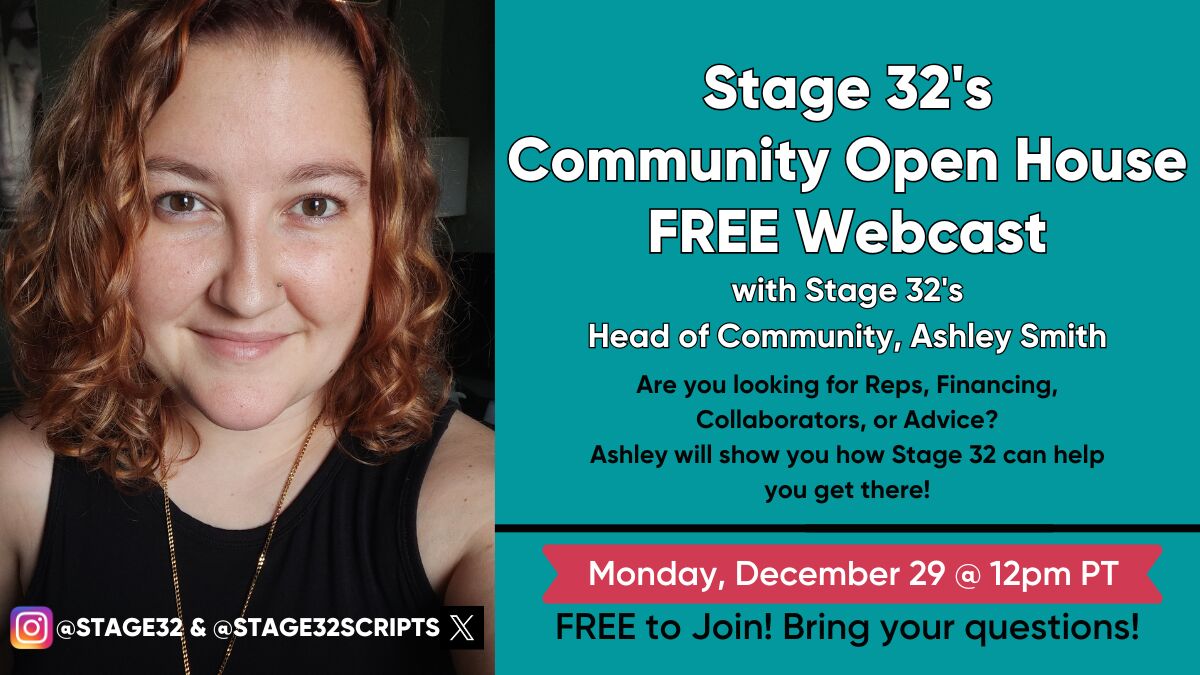
In this information-packed webinar, Heidi Lux will take you through the basics of screenplay formatting - and how to use formatting to show your voice as a writer. Heidi will walk you through writing descriptions, get more with less, and use formatting to set your script apart from the others - without changing a word of story.
Heidi is a produced screenwriter who believes that the “intangibles” that set a script apart actually are tangible - and can be taught. Heidi has written for multiple Nickelodeon series, and wrote the Tubi original feature Crushed. She has a BFA from NYU’s Tisch School of the Arts. Heidi is passionate about the craft of screenwriting and excited to share her knowledge with the Stage 32 community.
This webinar is more than just margins and designed for all levels of writers. You’ll walk away feeling comfortable with the “trickier” parts of formatting that even seasoned professionals struggle with. You’ll learn the key formatting rule that will allow you to break the rules, leaving you more confident as a writer.
Sign up link: https://www.stage32.com/education/c/education-webinars?h=your-guide-to-p...
Email edu@stage32.com with any questions




1 person likes this
Questions for webinar from Judy: 1. How do you decide between Action, Montage or Camera Shots?
2. Is each formatted differently?
2 people like this
I'm signed up. Do you use "The Screenwriter's Bible" by David Trottier?
2 people like this
Thanks, Judy. Sometimes it gives multiple options, like for flashbacks. I'm interested to find out what options people have selected and whether Heidi will have advice on situations like this.
3 people like this
If I would have had the money I would check out this webinar too. Things like only capping people that have dialog when introduced for the first time, and only capping a sound that a humans makes os, don,'t seem to exist anymore. Now the trend seems to be capping as little as possible; (1) not to emphasize; (2) no props; (and please) (3) no verbs, but it seems you must cap all humans first introduced, with or without dialog -- hey, even better, let us cap ALL living beings, ALL the time. I mean, try to cap the word(s) "student" or "students," or "police man/men" in whatever form, if both occur in you script A LOT!. Your script is going to look like an uther mess!! But if you only cap people that have dialog while first introduced, I guarantee you at least 60% of readers/executives will tell you that you're making a mistake, and if you point to The Hollywood Standard," they tell you on auto pilot "yes, but this rule and others only apply to production scripts, not specs, which, talking capping, isn't true either. Took me a long time to finally decide that I stick to the THS for as long as they do not update their own rules. Probably have to make some changes on the screenplays I worked on for the gazillion time! Isn't creating screenplsys fun?!
About flashbacks, I would combine the knowledge of The Hollywood Standard and David Trottier's
AKA Dr. Format, examples:
https://www.keepwriting.com/tsc/flashback.htm
In other words: it feels that there are more ways of doing it right, than there are ways of doing it wrong. For me a wisdom, not a rule, would be: "whatever way/form or ways/forms of describing a flashback (or whatever other format thingy) you use, DO IT CONSISTENTLY!"
But that's just me. As all of this is just my two cents.
2 people like this
I'm writing about a true story. Is formatting different for that genre? If so, in what ways?
1 person likes this
Great questions everyone, excited for the live Q+A!
2 people like this
THANK YOU Sydney S
3 people like this
Answering your question Sheree, ... No. It's just my humble opinion reading a lot of screenplays and never seing it mentioned in screenwriting books. Personally, I would keep the formatting 'solemn'; cap, italic, bold, underline as less as I can, let the story speak for itself and thereby create the emotional impact. But that's just me. If you get the oppertunity, ask a pro.
4 people like this
Hello, Everyone * I'm new to the craft but working with a producer, developing a short story I wrote into a feature. Is it proper to include things like Transition shots in a Spec script? I was told not to worry about formatting (at least for now) but I thought those kinds of notations were determined by the director. I'm also looking for format clarification on how to begin and end Montages and Flashbacks. Thanks so much!
3 people like this
Stephanie, the advice I've gotten from a lot of people is to leave most transitions out and just specify what a viewer would see in the final product. So, you don't need a FADE, for example, or CUT TO, in most cases. I put the the effect in the action descriptions. So, instead of fade, I might open the next scene with "THE NEXT MORNING..." to indicate that the action ended on one day and continued the next. The director or editor would probably fade it out and then fade in, for example, or use another device to show the transition of time. I think for a spec script you want to keep the reader in the story as much as possible, and transitions take them out of the story to think about how it is being presented.
For flashbacks, I think the key thing is clarity. I looked in David Trottier's "The Screenwriter's Bible" and there are several ways to do these. After trying some, I use "FLASHBACK" underlined at the start and a transition like "BACK TO SCENE" or "END FLASHBACK" at the end (also underlined). This allows me to have one or more scenes in the flashback, and it is clear where the flashback begins and ends. It is hard to miss underlined, all caps action lines, and I think this makes it easy to refer back to find the beginning of the flashback from the end.
I don't think a montage need the same treatment because the elements should be very short.
MONTAGE - FUN AT AMUSEMENT PARK
Myra and Sam enjoy themselves at the park.
-- They go on the Ferris wheel.
-- They dance at the dance hall.
[The next scene or sub-scene starts with a heading or subheading.]
I'm interested to know what other people think about formatting these.
3 people like this
Rich, thanks so much for your detailed response! I'd been following the formatting you described for the Montages and Flashbacks but I'm a little paranoid: I didn't have any scripts in my reading pile that used them and my inner OCD voice kept saying, "Can't be that simple!"
Transitions weren't even on my radar until I recently watched some tutorials that used them in samples. Like you, I'd been putting directives for Transitions in Action Lines but started second-guessing myself. I guess it's time to stop doing that!
Thanks again for taking the time to respond :)